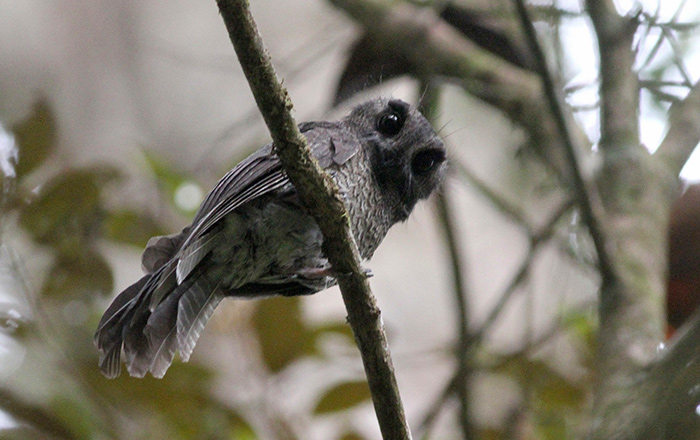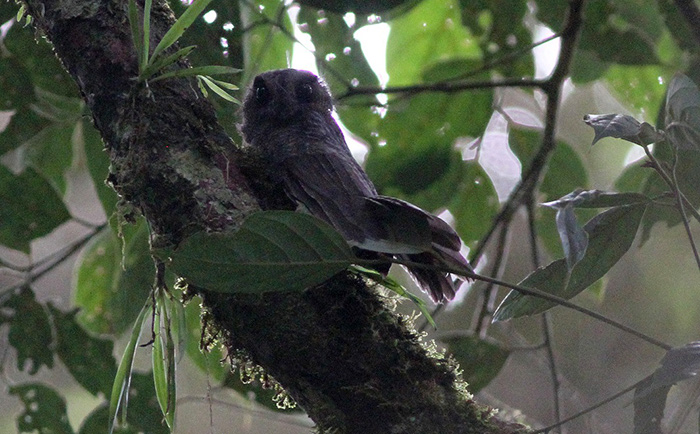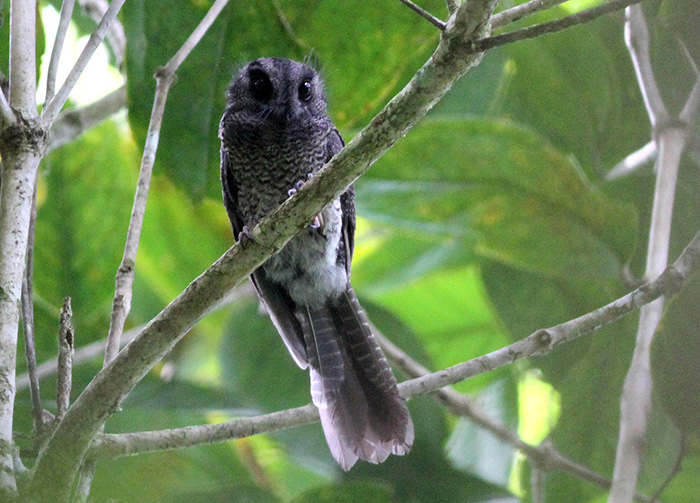Karimui Owlet-nightjar - rediscovered after half a century
by Ashley Banwell - ashleybanwellsbirding.com

Aegotheles affinis terborgi is only known from a single specimen taken at 1100 meters from the Karimui Basin in the Eastern Highlands of Papua New Guinea on 16th August 1964. This individual was presented to Jared M. Diamond by a native who said he had caught it by hand while it was sleeping on a branch during the day. JMD named this distinctive race after Dr John Terborgh was had accompanied him on a 1964 collecting trip to Karimui. Since its discovery it had been place under Barred Owlet-nightjar A bennettii based upon its close similarity to the two mainland races of A bennettii but it was distinct from these races in its much larger size, wing length being 154mm compared with A bennetti bennettii which has a 121-128 wing, as well as its much darker blacker upper parts. Handbook of the Birds of the World Alive currently places it under Allied Owlet-nightjar A affinis and the recent Birds of New Guinea - Distribution, Taxonomy and Systematics places it under Barred A bennettii.
The other population of Allied is present in the Arfak Mountains of the Bird's head Peninsular in West Papua at the elevation of 80-1500m which is some 1400 kms to the west. Most authors agree that it is a good possibility that it may well be a full species but further observations and recordings of its vocalisations would be required to increase the knowledge of this taxon.
Having a keen interest on nocturnal birding and combined with my passion for Papuan birding I had been aware that there may well be something of great interest hiding on the old volcano at Karimui. I had been making enquiries about visiting the region for a couple of years and finally in July 2016 I was back in Port Morseby with Karimui next up on my agenda. Despite Air Niugini's best efforts to cancel my plans and the countries Prime Minister facing a vote of no confidence we eventually made it into Goroka via Lae, not as we planned but we were ready for our MAFF charter flight into Karimui. So Markus Lagerqvist, Roger McNeill, Daniel Wakra and myself had four nights in Karimui to find an owlet-nightjar without any recordings or information on where to look it suddenly seemed a tall order.

Our first night was in the Pastors house in the village and early next morning we set off with a ever increasing entourage aiming to climb as high as we could then make a camp. We finally came across a small wooden house on the edge of a cleared area and as rain seemed highly probable we decided to use this as our base and from there explore the higher areas.
Five local lads came along with us for our first real exploration and as we approached 1570 metres one of the lads shook a rattan vine and remarkably a grey looking owlet-nightjar flew out and landed directly above Markus and myself, the first view was looking right up from underneath, as my camera was ready I instinctively fired a couple of shots of before very quickly positioning myself so I was looking at it front on and managed a couple of photos before it flew off.

To my relief and surprise I had actually got a nice photo of what I had hoped it would be, a Karimui Owlet-nightjar, the first ever live observation 52 years after its initial discovery.
The bird was quickly relocated and we were able to watch it for an hour or so in rather poor light but it did move several times and at one point it went inside a small hole but only briefly. It finally settled and sat unobstructed until enough photos and videos were made everyone was satisfied and they left, I remained for a while after they all left just to have a moment of one on one and not really wanting to leave while it was still on view, the owlet-nightjar finally out stared me and rather reluctantly I made my way back down to camp not really believing what had just happened. A rather desperate and hopeless search had resulted with a wonderful sighting. Some sound recordings were made the following evening but it only made one series of calls at dusk and there was a lot of background insect and frog noise.
Ashlet Banwell
30 August 2016
Write for Rare Bird Alert
Do you have a birding story you would like to share? From foreign birding trips to your local patch, finders accounts and more, we would love to hear from you.
All our articles are free for anyone to view and we include them in our weekly newsletter which goes out to thousands of birders every Wednesday. We also share them on our Twitter and Facebook pages, making sure your article will get read by as many people as possible.
If you would like to write an article please for us please get in touch with your ideas, thank you.
The RBA team






